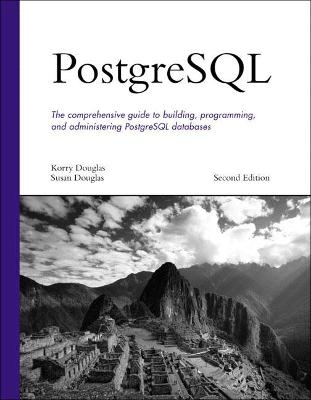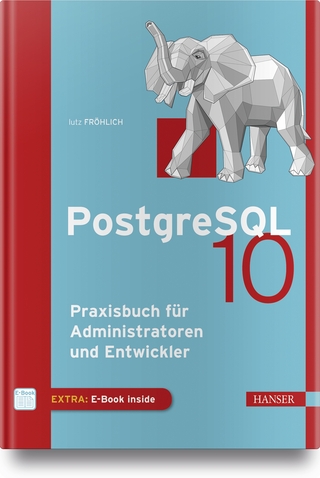
PostgreSQL
Sams Publishing (Verlag)
978-0-672-32756-8 (ISBN)
- Titel erscheint in neuer Auflage
- Artikel merken
The second edition of the best-selling PostgreSQL has been updated to completely cover new features and capabilities of the 8.0 version of PostgreSQL. You will be lead through the internals of the powerful PostgreSQL open source database chapter, offering an easy-to-read, code-based approach that makes it easy to understand how each feature is implemented, how to best use each feature, and how to get more performance from database applications. This definitive guide to building, programming and administering the powerful PostgreSQL open-source database system will help you harness one of the most widely used open source, enterprise-level database systems.
Korry Douglas is the Director of Research and Development for Appx Software. Over the last two decades he has worked on the design and implementation of an umber of high-level languages and development environments, and his work with a variety of database products (Oracle, Sybase, SQL Server, PostgreSQL, MySQL and mSQL) given him a unique understanding of the commonalities of, and differences between, databases.
Introduction.
PostgreSQL Features
What Versions Does This Book Cover?
Who Is This Book For?
What Topics Does This Book Cover?
What's New in the Second Edition?
I. GENERAL POSTGRESQL USE.
1. Introduction to PostgreSQL and SQL.
A Sample Database
Basic Database Terminology
Prerequisites
Installing PostgreSQL Using an RPM
Connecting to a Database
A (Very) Simple Query
Creating Tables
Viewing Table Descriptions
Adding New Records to a Table
Using the INSERT Command
Using the COPY Command
Installing the Sample Database
Retrieving Data from the Sample Database
SELECT Expression
SELECT FROM Table
SELECT Single-Column FROM Table
SELECT Column-List FROM Table
SELECT Expression-List FROM Table
Selecting Specific Rows
The CASE Expression
Formatting Column Results
Matching Patterns
Aggregates
COUNT()
SUM()
AVG()
MIN() and MAX()
Other Aggregate Functions
Grouping Results
Multi-Table Joins
Join Types
UPDATE
DELETE
A (Very) Short Introduction to Transaction Processing
Creating New Tables Using CREATE TABLE...AS
Using VIEW
Summary
2. Working with Data in PostgreSQL.
NULL Values
Character Values
Syntax for Literal Values
Supported Operators
Numeric Values
Size, Precision, and Range-of-Values
Syntax for Literal Values
Supported Operators
Date/Time Values
Syntax for Literal Values
Supported Operators
Boolean (Logical) Values
Size and Valid Values
Syntax for Literal Values
Supported Operators
Geometric Data Types
Syntax for Literal Values
Sizes and Valid Values
Supported Operators
Object IDs (OID)
Syntax for Literal Values
Size and Valid Values
Supported Operators
BLOBs
Syntax for Literal Values
Supported Operators
Large-Objects
Network Address Data Types
MACADDR
CIDR
INET
Syntax for Literal Values
Supported Operators
Sequences
Arrays
Column Constraints
NULL/NOT NULL
UNIQUE
PRIMARY KEY
REFERENCES
CHECK()
Expression Evaluation and Type Conversion
Creating Your Own Data Types
Refining Data Types with CREATE DOMAIN
Creating and Using Composite Types
Summary
3. PostgreSQL SQL Syntax and Use.
PostgreSQL Naming Rules
The Importance of the COMMENT Command
Creating, Destroying, and Viewing Databases
Tablespaces
Creating New Databases
Dropping a Database
Viewing Databases
Creating New Tables
Temporary Tables
Table Constraints
Dropping Tables
Inheritance
ALTER TABLE
Adding Indexes to a Table
Tradeoffs
Creating an Index
Functional Indexes and Partial Indexes
Creating Indexes on Array Values
Indexes and Tablespaces
Getting Information About Databases and Tables
Transaction Processing
Persistence
Transaction Isolation
Multi-Versioning and Locking
Summary
4. Performance.
How PostgreSQL Organizes Data
Page Caching
Summary
Gathering Performance Information
Dead Tuples
Index Performance
Understanding How PostgreSQL Executes a Query
EXPLAIN
Seq Scan
Index Scan
Sort
Unique
LIMIT
Aggregate
Append
Result
Nested Loop
Merge Join
Hash and Hash Join
Group
Subquery Scan and Subplan
Tid Scan
Materialize
Setop (Intersect, Intersect All, Except, Except All)
Execution Plans Generated by the Planner
The ARC Buffer Manager
Table Statistics
Performance Tips
II. PROGRAMMING WITH POSTGRESQL.
5. Introduction to PostgreSQL Programming.
Server-Side Programming
PL/pgSQL
Other Procedural Languages Supported by PostgreSQL
Extending PostgreSQL Using External Languages
Client-Side APIs
General Structure of Client Applications
Connection Properties
LISTEN/NOTIFY
Choosing an Application Environment
Server-Side Code
Client-Side Code
Mixing Server-Side and Client-Side Code
Summary
6. Extending PostgreSQL.
Extending the PostgreSQL Server with Custom Functions
Returning Multiple Values from an Extension Function
The PostgreSQL SRF Interface
Returning Complete Rows from an Extension Function
Extending the PostgreSQL Server with Custom Data Types
Internal and External Forms
Defining a Simple Data Type in PostgreSQL
Defining the Data Type in C
Defining the Input and Output Functions in C
Defining the Input and Output Functions in PostgreSQL
Defining the Data Type in PostgreSQL
Indexing Custom Data Types
Summary
7. PL/pgSQL.
Installing PL/pgSQL
Language Structure
Quoting Embedded Strings
CREATE FUNCTION
DROP FUNCTION
Function Body
Comments
Variables
PL/pgSQL Statement Types
Cursors
FETCH
Parameterized Cursors
Cursor References
Triggers
TRIGGER Return Values
TRIGGER Function Arguments
Polymorphic Functions
PL/pgSQL and Security
Summary
8. The PostgreSQL C API-libpq.
Prerequisites
Client 1-Connecting to the Server
Compiling the Client
Identifying the Server
Client 2-Adding Error Checking
Viewing Connection Attributes
Client 3-Simple Processing-PQexec() and PQprint()
Results Returned by PQexec()
The Prepare/Execute Model
Client 4-An Interactive Query Processor
Processing Multiple Result Sets
Asynchronous Processing
Summary
9. A Simpler C API-libpgeasy.
Prerequisites
Client 1-Connecting to the Server
Client 2-Adding Error Checking
Client 3-Processing Queries
Working with Binary Cursors
Byte Ordering and NULL Values
Client 4-An Interactive Query Processor
Summary
10. The New PostgreSQL C++ API-libpqxx.
Prerequisites
Client 1-Connecting to the Server
Using pqxx-config to Create a Simple Makefile
connection Member Functions
Client 2-Adding Error Checking
Other Exceptions Thrown by libpqxx
Handling Informational/Warning Messages with Notice Processor Objects
Client 3-Processing Queries
Working with Transactions
Working with Result Sets
Working with Large-Objects
LISTEN/NOTIFY
set_variable() and get_variable()
Client 4-Working with transactors
Summary
11. Embedding SQL Commands in C Programs-ecpg.
Prerequisites
Client 1-Connecting to the Server
The ecpg Preprocessor
Connection Strings
Client 2-Adding Error Checking
The sqlca Structure
Client 3-Processing SQL Commands
ecpg Data Types
Client 4-An Interactive Query Processor
Summary
12. Using PostgreSQL from an ODBC Client Application.
ODBC Architecture Overview
The ODBC Client Application
The ODBC Driver Manager
The ODBC Driver
The ODBC-Compliant Database
The Data Source
Setting Up a Data Source on Unix Systems
Setting Up a Data Source in Windows
Datasource Connection Properties
Prerequisites
Client 1-Connecting to the Server
Client 2-Adding Error Checking
Client 3-Processing Queries
Client 4-An Interactive Query Processor
Summary
Resources
13. Using PostgreSQL from a Java Client Application.
JDBC Architecture Overview
The JDBC DriverManager
The JDBC Driver
The JDBC-Compliant Database
Prerequisites
Client 1-Connecting to the Server
JDBC URLs
Client 2-Adding Error Checking
JNDI and the DataSource Class
Client 3-Processing Queries
Statement Classes
Metadata
Client 4-An Interactive Query Processor
Summary
14. Using PostgreSQL with Perl.
DBI Architecture Overview
The DBI
The DBD Driver
The DBI-Compliant Database
Prerequisites
Client 1-Connecting to the Server
DBI URLs
Client 2-Adding Error Checking
Client 3-Processing Queries
The Prepare/Execute Model
Metadata and Result Set Processing
Other Statement and Database Handle Attributes
Client 4-An Interactive Query Processor
Summary
15. Using PostgreSQL with PHP.
PHP Architecture Overview
Prerequisites
Client 1-Connecting to the Server
Client 2-Adding Error Checking
Client 3-Query Processing
Other Ways to Retrieve Result Set Values
Metadata Access
Client 4-An Interactive Query Processor
Other Features
Summary
16. Using PostgreSQL with Tcl and Tcl/Tk.
Prerequisites
Client 1-Connecting to the Server
Making the Connection Dialog Reusable
Client 2-Query Processing
Result Set Processing
Client 3-An Interactive Query Processor
The libpgtcl Large-Object API
Summary
17. Using PostgreSQL with Python.
Python/PostgreSQL Interface Architecture
Prerequisites
Client 1-Connecting to the Server
Client 2-Adding Error Checking
Client 3-Query Processing
Client 4-An Interactive Command Processor
Summary
18. Npgsql: The .NET Data Provider.
Prerequisites
Preparing Visual Studio
Understanding the ADO.NET Class Hierarchy
Creating an Npgsql-enabled VB Project
Client 1-Connecting to the Server
Client 2-An Interactive Query Processor
Client 3-Updating the Database with a DataSet
Client 4-A More Robust Query Processor
Client 5-Using a Typed DataSet
Creating a Typed DataSet
Summary
19. Other Useful Programming Tools.
PL/Java-Writing Stored Procedures in Java
Installing PL/Java
Writing a Simple PL/Java Function
Accessing the Database from a PL/Java Function
Returning Multiple Results from a PL/Java Function
Writing PL/Java Trigger Functions
Adding Install/Uninstall Commands to a Jar File
pgcurl-Web-enabling Your PostgreSQL Server
pgbash-Writing PostgreSQL-enabled Shell Scripts
III. POSTGRESQL ADMINISTRATION.
20. Introduction to PostgreSQL Administration.
Security
User Accounts
Backup and Restore
Server Startup and Shutdown
Running PostgreSQL on a Windows Host
Tuning
Installing Updates
Localization
Summary
21. PostgreSQL Administration.
Roadmap (Where's All My Stuff?)
Installing PostgreSQL
Unix/Linux
Windows
Managing Databases
Creating a New Cluster
Creating a New Database
Routine Maintenance
Logfile Rotation
The PostgreSQL BGWRITER Process
Managing User Accounts
CREATE USER
Managing Groups
Configuring Your PostgreSQL Runtime Environment
File Locations
Security-Related Parameters
Connection-Related Parameters
Operational Parameters
Write-Ahead Log Parameters
Optimizer Parameters
Debugging/Logging Parameters
Performance Statistics
Per-session Parameters
Miscellaneous Parameters
Read-only Parameters
Arranging for PostgreSQL Startup and Shutdown
Using pg_ctl
Shutdown Modes
Configuring PostgreSQL Startup on Unix/Linux Hosts
Backing Up and Copying Databases
Using pg_dump
Using pg_dumpall
Using pg_restore
Point-in-time Recovery
Summary
22. Internationalization and Localization.
Locale Support
Enabling Locale Support
Effects of Locale Support
PostgreSQL Locale Summary
Multi-Byte Character Sets
Encodings Supported by PostgreSQL
Enabling Multi-Byte Support
Selecting an Encoding
Client/Server Translation
Summary
23. Security.
Securing the PostgreSQL Data Files
Securing PostgreSQL Data Files in Windows
Securing Network Access
local Connections
host, hostssl, and hostnossl Connections
The trust Authentication Method
The ident Authentication Method
The password Authentication Method
The crypt Authentication Method
The md5 Authentication Method
The pam Authentication Method
The krb4 and krb5 Authentication Methods
The reject Authentication Method
Securing Tables
Securing Functions
Summary
24. Replicating PostgreSQLData with Slony.
Overview
Requirements
Creating a Replication Cluster
Starting the Replication Daemons
Creating a Replication Set
Subscribing to a Replication Set
Copying Table and Sequence Definitions
Creating a Subscriber
Changing the Cluster Topology (Re-mastering and Failover)
Summary
25. Contributed Modules.
Exchanging PostgreSQL Data with XML
XPath Queries
Converting XML Data with XSLT
Using Full-text Search
Searching Multiple Columns
Simplifying tsearch2 with Customized Functions
Searching for Phrases
Configuring tsearch2
Index.
| Erscheint lt. Verlag | 25.8.2005 |
|---|---|
| Reihe/Serie | Developer's Library |
| Verlagsort | Indianapolis |
| Sprache | englisch |
| Maße | 178 x 236 mm |
| Gewicht | 1760 g |
| Themenwelt | Informatik ► Datenbanken ► PostgreSQL |
| Mathematik / Informatik ► Informatik ► Software Entwicklung | |
| ISBN-10 | 0-672-32756-2 / 0672327562 |
| ISBN-13 | 978-0-672-32756-8 / 9780672327568 |
| Zustand | Neuware |
| Haben Sie eine Frage zum Produkt? |
aus dem Bereich



